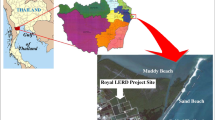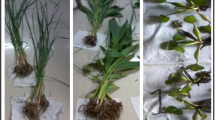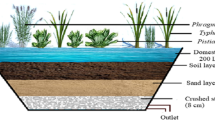Abstract
Constructed wetlands (CWs) are capable of removing pollutants from the water environment; therefore, they are used for treating domestic, industrial, municipal, and mine drainage wastewater. In this study, we investigated the potential use of microcosm scale constructed wetlands (MCWs) to treat boron (B) from modified river water contaminated by boron (B). MCW treatment systems were designed according to mono-culture parameters with Carex divisa (Cyperaceae), and one unplanted system was also designed as control. The performances of the MCW treatment systems were assessed for 42 days under field conditions in Western Anatolia (Eskişehir, Turkey). Correspondingly, we found that MCW systems with plant cover had better removal performance in comparison with unplanted systems, and B treatment performances in the research period were ranged from 29.9 to 70.6% for treatment systems (MCWs) and from 21.3 to 44% for unplanted control. Furthermore, nitrate (NO3−) and ammonium (NH4+) concentrations were also monitored during the treatment period, and NO3− treatment performances were ranged from 84.58 to 90.38% and from 68.19 to 79.44% for MCWs and unplanted control respectively, and NH4+ treatment performances were ranged from 87.12 to 92.19% for treatment systems (MCWs) and from 77.98 to 81.36% for unplanted control. The results from the present experiment suggested that MCW treatment systems have a potential for removal of B from polluted river water, and thus, this type of system could be used as an alternative treatment method for contaminated river water in Western Anatolia which has the biggest borax reserve in over the world.
Similar content being viewed by others
Explore related subjects
Discover the latest articles, news and stories from top researchers in related subjects.Avoid common mistakes on your manuscript.
Introduction
Boron (B) is one of the necessary micronutrients for the usefulness of plant (Brown et al. 2002; Işık and Çalıseki 2017), often situated in growing concentrations in wastewater in consequence of domestic, industrial, and mining use (Hasenmueller and Criss 2013). Boron concentrations may become undesirable when present at different levels (Camacho-Cristóbal et al. 2008). While nutrient insufficiencies occur at comparatively low concentrations of B, toxic effects are seen at higher levels in plants (Camacho-Cristóbal et al. 2008). In plants, boron toxicity is related to both B concentrations in sediment solution and irrigation water, as well as tolerance mechanisms in plants. Hence, concentrations of boron in sediment solution and irrigation water should be at levels not passing 10 mg l−1 and 4 mg l−1, respectively (Nable et al. 1997). In accordance with the latest evidence, in 2009, the Drinking Water Quality Committee recommended 2.4 mg l−1 as the level of B in the water (Wolska and Bryjak 2013). It is necessary to limit B in the wastewater taking into account hard environmental production instructions and public health problems (Türker et al. 2017a). Boron toxicity is an important environmental problem for native and crop plants growing over semi-arid and arid zones with the inclusion of the USA, Australia, and North Africa (Nable et al. 1997; Türker et al. 2017b). Turkey has the biggest B reserves that find an important place in terms of B mining (Türe and Bell 2004). Turkey’s reserves Kirka (Eskisehir), Kestelek (Bursa), Emet (Kütahya), Sultançayır, and Bigadiç (Balikesir) are located within the boundaries (Kistler and Helvacı 1994; Böcük et al. 2013). Constructed wetland (CW) treatment systems, one of the phyto-engineering techniques, are described as an eco-friendly technology with low-cost, easy-operation/maintenance, and more sustainable technique for removing pollutants from wastewater (Türker et al. 2017c). Constructed wetlands using low energy are utilized in a wide perspective, from industrial to urban, irrigation and drainage from urban waters to agricultural and mine drainage (Vymazal 2014). In this study, we investigated the potential use of microcosm scale constructed wetlands (MCWs) with Carex divisa to purify boron (B) from simulated river water contaminated by boron.
Materials and methods
Wetland design
This article is part of the Topical Collection on Geo-Resources-Earth-Environmental SciencesThe research was carried out at Anadolu University, Department of Biology, Eskisehir, Turkey. The investigated area is under the influence of the semi-arid Mediterranean climate, with an average annual rainfall of 373.8 mm and a mean temperature of 10.8 °C. Four microcosm scale constructed wetlands (MCWs) (three replicate planted systems and one unplanted constructed wetlands) were produced and drafted utilizing plastic containers with 40-cm length, 30-cm width, and 28-cm depth for each system. MCWs were separated as C. divisa (with three replicate) [MCW1] and unplanted control (MCW2) according to the presence of vegetation in their matrices and positioned outside. Rhizomes of C. divisa were obtained from natural wetlands in Eskisehir, Turkey (39° 17′ N, 30° 30′ E), and the rhizomes were instantly sown in the respectively constructed wetlands in a vegetate density of approximately 16 rhizomes/m2. Before the experiment begins, constructed wetlands were grown for 30 days in a blend of domestic wastewater and Hoagland medium to promote the plant growth and improve microorganism (Türker et al. 2016).
Boron concentration and execution of wetland systems
With the completion of the 30-day culture period, the MCW systems were fully established for the bioremediation process of boron. This study conducted an investigation on the modified wastewater formed with river water polluted with six different boron concentrations changing from 4 to 128 mg /L (Table 2). This reason for choosing the modified wastewater similar contaminant level in the runoff water and certain sewerage in Turkey was made up (Türker et al. 2017c). The performance of the MCW treatment systems was assessed for 42 days under natural conditions in the Western Anatolia (Eskişehir, Turkey).
Wastewater sampling and analysis
Influent and effluent water samples from each wetland system were taken in accordance with the hydraulic retention time along the study period (7 days). pH, temperature, dissolved oxygen, redox potential, and electrical conductivity (EC) in wastewater samples were gauged with HACH HQ40D multi-parameter meter measuring instrument. Boron (B) concentrations in effluent and influent water were identified with respect to the carminic acid method (Adams 1990). The proportion of ammonium (NH4+) and nitrate (NO3−) in wastewater samples were determined by utilizing an ammonium electrode (INTELLICAL ISE ammonium electrode, 2406549) and nitrate electrode (INTELLICAL ISE Nitrate electrode, 2984790).
Equations
Boron (B), ammonium (NH4+), and nitrate (NO3−) removal efficiencies of MCWs in wastewater were calculated as:
where Ci and Ce are the B, NO3−, and NH4+ concentrations of wastewater samples in mg/L.
Results and discussion
Different boron doses were realized to the MCWs depending on the flow fluctuations to simulate the realistic wastewater composition. The outflow B concentrations were less than inflow in this research and showed that all wetland systems could remove B in wastewater samples (p < 0.05). The total boron treatment performance of the planted MCWs calculated to 57.7 % with a mean inlet boron concentration of 43.6 mg l−1. MCW systems with plant cover had better removal performance in comparison with unplanted systems, and B treatment performances in the study period were ranged from 29.9 to 70.6% for planted systems (MCWs) and from 21.3 to 44% for unplanted control. Table 2 shows the B concentration and B removal performances of the inlet and outlet water samples of MCWs in detail. In MCWs planted with C. divisa, the effluent removal efficiency was found to be relatively effective when compared to the productivity of planted CW systems for the treatment of B from wastewater. Ye et al. (2003) announced the B treatment performance of 32% for microcosm CWs with various wetland plants. Allende et al. (2012) obtained that microcosm scale CW vegetated with Phragmites australis refined 12.5% B from the wastewater at the 7 weeks. Kröpfelová et al. (2009) found 21.8% and 25.1% treatment performance of B in two SSFCW with P. australis planned to cure domestic wastewater. Türker et al. (2013) reported boron removal of 27.2%, 40.7 % from B mine wastewater in monoculture CWs. Türker et al. (2016) stated B removal of 53.7 % for CWs with Juncus gerardii. As a result, we found 57.7% boron removal with higher efficiency in MCWs which have vegetated C. divisa in this experiment.
Nitrification and denitrification operations ensure that the wetland system works efficiently by providing nitrogen removal. Nitrification just transforms nitrogen into various forms but did not remove nitrogen (Vymazal and Březinová 2015). Nitrate and ammonium concentrations were also monitored during the treatment period, and NO3− treatment performances were ranged from 84.58 to 90.38% and from 68.19 to 79.44% for MCWs and unplanted control, respectively. Ammonium treatment performances were ranged from 87.12 to 92.19% for treatment systems (MCWs) and from 77.98 to 81.36% for unplanted control, respectively. In the existence of vegetation aerobic environment formed a more convenient stage of nitrification, and thus, the ammonium treatment efficiency of planted wetland systems was higher than unplanted control systems. Water physicochemical parameters of the outflow samples from MCWs are shown in Table 1.
Conclusions
The results obtained from the experiment suggested that MCWs with C. divisa treatment systems have a potential to treat B from contaminated river water, and thus, this type of systems could be used as an alternative treatment method for contaminated river water in Western Anatolia which has the biggest borax reserve in over the world.
References
Adams V (1990) Water and wastewater examination manual, vol 247. CRC Press LLC, Florida
Allende KL, Fletcher T, Sun G (2012) The effect of substrate media on the removal of arsenic, boron and iron from an acidic wastewater in planted column reactors. Chem Eng J 179:119–130. https://doi.org/10.1016/j.cej.2011.10.069
Böcük H, Yakar A, Türker OC (2013) Assessment of Lemna gibba L. (duckweed) as a potential ecological indicator for contaminated aquatic ecosystem by boron mine effluent. Ecol Indic 29:538–548
Brown PH, Bellaloui N, Wimmer MA, Bassil ES, Ruiz J, Hu H, Pfeffer H, Dannel F, Romheld V (2002) Boron in plant biology. Plant Biol 4:205–223. https://doi.org/10.1055/s-2002-25740
Camacho-Cristóbal JJ, Rexach J, González-Fontes A (2008) Boron in plants: deficiency and toxicity. J Integr Plant Biol 50(10):1247–1255. https://doi.org/10.1111/j.1744-7909.2008.00742.x
Hasenmueller EA, Criss RE (2013) Multiple sources of boron in urban surface waters and groundwaters. Sci Total Environ 447:235–247. https://doi.org/10.1016/j.scitotenv.2013.01.001
Işık G, Çalıseki M (2017) Ecophysiological effects of Porsuk River’s water and boron mine wastewater on Cucumis sativus L. Seeds. Acta Phys Pol A 132(3):746–748. https://doi.org/10.12693/APhysPolA.132.746
Kistler RB, Helvacı C (1994) Boron and borates. In: Carr DD (ed) Industrial Minerals and Rocks, 6th edn. SME Society of Mining, Metalurgy and Exploration Inc., Littleton pp, pp 171–186
Kröpfelová L, Vymazal J, Svehla J, Stíchová J (2009) Removal of trace elements in three horizontal sub-surface flow constructed wetlands in the Czech Republic. Environ Pollut 157(4):1186–1194. https://doi.org/10.1016/j.envpol.2008.12.003
Nable RO, Banuelos GS, Paul JG (1997) Boron Toxicity. Plant Soil 193:181–198. https://doi.org/10.1023/A:1004272227886
Türe C, Bell RW (2004) Plant distribution and its relationship to extractable boron in naturally-occurring high boron soils in Turkey. Isr J Plant Sci 52:125–132
Türker OC, Türe C, Bocük H, Yakar A (2013) Constructed wetlands as green tools for management of boron mine wastewater. Int J Phytoremediat 16(6):537–553. https://doi.org/10.1080/15226514.2013.798620
Türker OC, Türe C, Bocük H, Çiçek A, Yakar A (2016) Role of plants and € vegetation structure on boron (B) removal process in constructed wetlands. Ecol Eng 88:143–152. https://doi.org/10.1016/j.ecoleng.2015.12.021
Türker OC, Türe C, Yakar A, Saz Ç (2017a) Engineered wetland reactors with different media types to treat drinking water contaminated by boron (B). J Clean Prod 168:823–832. https://doi.org/10.1016/j.jclepro.2017.09.067
Türker OC, Yakar A, Gür N (2017b) Bioaccumulation and toxicity assessment of irrigation water contaminated with boron (B) using duckweed (Lemna gibba L.) in a batch reactor system. J Hazard Mater 324:151–159. https://doi.org/10.1016/j.jhazmat.2016.10.044
Türker OC, Türe C, Yakar A, Saz Ç (2017c) Engineered wetland reactors with different media types to treat drinking water contaminated by boron (B). J Clean Prod 168:823–832. https://doi.org/10.1016/j.jclepro.2017.09.067
Vymazal J (2014) Constructed wetlands for treatment of industrial wastewaters: a review. Ecol Eng 73:724–751
Vymazal J, Březinová T (2015) The use of constructed wetlands for removal of pesticides from agricultural runoff and drainage: a review. Environ Int 75:11–20. https://doi.org/10.1016/j.envint.2014.10.026
Wolska J, Bryjak M (2013) Methods for boron removal from aqueous solutions- a review. Desalination 310:18–24. https://doi.org/10.1016/j.desal.2012.08.003
Ye Z, Lin ZQ, Whiting S, De Souza M, Terry N (2003) Possible use of constructed wetland to remove selenocyanate, arsenic, and boron from electric utility wastewater. Chemosphere 52(9):1571–1579. https://doi.org/10.1016/S0045-6535(03)00497-1
Acknowledgments
This research is supported by Anadolu University Scientific Research Project no 1706F383.
Author information
Authors and Affiliations
Corresponding author
Additional information
This article is part of the Topical Collection on Geo-Resources-Earth-Environmental Sciences
Rights and permissions
About this article
Cite this article
Işık, G., Saz, Ç., Türker, O.C. et al. Boron removal with microcosm constructed wetlands (MCWs) with Carex divisa for treating contaminated river water. Arab J Geosci 13, 541 (2020). https://doi.org/10.1007/s12517-020-05539-9
Received:
Accepted:
Published:
DOI: https://doi.org/10.1007/s12517-020-05539-9




